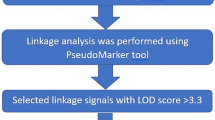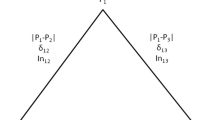Abstract
Previously, we performed a genome scan for type 2 diabetes (T2DM) using 638 African-American (AA) affected sibling pairs from 247 families; non-parametric linkage analysis suggested evidence of linkage at 6q24–27 (LOD 2.26). To comprehensively evaluate this region, we performed a two-stage association study by first constructing a SNP map of 754 SNPs selected from HapMap on the basis of linkage disequilibrium (LD) in 300 AAT2DM end-stage renal disease (ESRD) subjects, 311 AA controls, 43 European American controls and 45 Yoruba Nigerian samples (Set 1). Replication analyses were conducted in an independent population of 283 AA T2DM-ESRD subjects and 282 AA controls (Set 2). In addition, we adjusted for the impact of admixture on association results by using ancestry informative markers (AIMs). In Stage 1, 137 (18.2%) SNPs showed nominal evidence of association (P < 0.05) in one or more of tests of association: allelic (n = 33), dominant (n = 36), additive (n = 29), or recessive (n = 34) genotypic models, and 2- (n = 47) and 3-SNP (n = 43) haplotypic analyses. These SNPs were selected for follow-up genotyping. Stage 2 analyses confirmed association with a predicted 2-SNP “risk” haplotype in the PARK2 gene. Also, two intergenic SNPs showed consistent genotypic association with T2DM-ESRD: rs12197043 and rs4897081. Combined analysis of all subjects from both stages revealed nominal associations with 17 SNPs within genes, including suggestive associations in ESR1 and PARK2. This study confirms known diabetic nephropathy loci and identifies potentially novel susceptibility variants located within 6q24–27 in AA.



Similar content being viewed by others
References
Barrett JC, Fry B, Maller J, Daly MJ (2005) Haploview: analysis and visualization of LD and haplotype maps. Bioinformatics 21:263–265
Buetow KH, Edmonson M, MacDonald R, Clifford R, Yip P, Kelley J, Little DP, Strausberg R, Koester H, Cantor CR, Braun A (2001) High-throughput development and characterization of a genomewide collection of gene-based single nucleotide polymorphism markers by chip-based matrix-assisted laser desorption/ionization time-of-flight mass spectrometry. Proc Natl Acad Sci USA 98:581–584
Carlson CS, Eberle MA, Rieder MJ, Yi Q, Kruglyak L, Nickerson DA (2004) Selecting a maximally informative set of single-nucleotide polymorphisms for association analyses using linkage disequilibrium. Am J Hum Genet 74:106–120
Carter JS, Pugh JA, Monterrosa A (1996) Non-insulin-dependent diabetes mellitus in minorities in the United States. Ann Intern Med 125:221–232
Craig RL, Chu WS, Elbein SC (2007) Retinol binding protein 4 as a candidate gene for type 2 diabetes and prediabetic intermediate traits. Mol Genet Metab 90:338–344
Duggirala R, Blangero J, Almasy L, Arya R, Dyer TD, Williams KL, Leach RJ, O’Connell P, Stern MP (2001) A major locus for fasting insulin concentrations and insulin resistance on chromosome 6q with strong pleiotropic effects on obesity-related phenotypes in nondiabetic Mexican Americans. Am J Hum Genet 68:1149–1164
Dupont WD, Plummer WD Jr (1990) Power and sample size calculations: a review and computer program. Control Clin Trials 11:116–128
Elbein SC, Wang X, Karim MA, Chu WS, Silver KD (2006) Analysis of coding variants in the betacellulin gene in type 2 diabetes and insulin secretion in African American subjects. BMC Med Genet 7:62
Emanuele N, Sacks J, Klein R, Reda D, Anderson R, Duckworth W, Abraira C (2005) Ethnicity, race, and baseline retinopathy correlates in the veterans affairs diabetes trial. Diabetes Care 28:1954–1958
Gabriel SB, Schaffner SF, Nguyen H, Moore JM, Roy J, Blumenstiel B, Higgins J, DeFelice M, Lochner A, Faggart M, Liu-Cordero SN, Rotimi C, Adeyemo A, Cooper R, Ward R, Lander ES, Daly MJ, Altshuler D (2002) The structure of haplotype blocks in the human genome. Science 296:2225–2229
Gallagher CJ, Gordon CJ, Langefeld CD, Mychaleckyj JC, Freedman BI, Rich SS, Bowden DW, Sale MM (2006) Association of the µ-opioid receptor gene with type 2 diabetes mellitus in an African American population. Mol Genet Metab 87:54–60
Gallagher CJ, Keene KL, Mychaleckyj JC, Langefeld CD, Hirschhorn JN, Henderson BE, Gordon CJ, Freedman BI, Rich SS, Bowden DW, Sale MM (2007a) Investigation of the estrogen receptor-alpha gene with type 2 diabetes and/or nephropathy in African-American and European-American populations. Diabetes 56:675–684
Gallagher CJ, Langefeld CD, Gordon CJ, Campbell JK, Mychalecky JC, Bryer-Ash M, Rich SS, Bowden DW, Sale MM (2007b) Association of the estrogen receptor-alpha gene with the metabolic syndrome and its component traits in African-American families: the insulin resistance atherosclerosis family study. Diabetes 56:2135–2141
Green LE, Lange EM, Langefeld CD (2001) Power comparisons of phase-known versus phase-unknown haplotype analyses for case–control designs. Am J Hum Genet 69:1948a
Hu G, Jousilahti P, Bidel S, Antikainen R, Tuomilehto J (2007) Type 2 diabetes and the risk of Parkinson’s disease. Diabetes Care 30:842–847
Juretic D, Krajnovic V, Lukac-Bajalo J (2002) Altered distribution of urinary glycosaminoglycans in diabetic subjects. Acta Diabetol 39:123–128
Karim MA, Wang X, Hale TC, Elbein SC (2005) Insulin promoter factor 1 variation is associated with type 2 diabetes in African Americans. BMC Med Genet 6:37
Karim MA, Craig RL, Wang X, Hale TC, Elbein SC (2006) Analysis of FOXO1A as a candidate gene for type 2 diabetes. Mol Genet Metab 88:171–177
Kitada T, Asakawa S, Hattori N, Matsumine H, Yamamura Y, Minoshima S, Yokochi M, Mizuno Y, Shimizu N (1998) Mutations in the parkin gene cause autosomal recessive juvenile parkinsonism. Nature 392:605–608
Kobayashi M, Sugumaran G, Liu J, Shworak NW, Silbert JE, Rosenberg RD (1999) Molecular cloning and characterization of a human uronyl 2-sulfotransferase that sulfates iduronyl and glucuronyl residues in dermatan/chondroitin sulfate. J Biol Chem 274:10474–10480
Lin HY, Wang CL, Hsiao PJ, Lu YC, Chen SY, Lin KD, Hsin SC, Hsieh MC, Shin SJ (2007) SUMO4 M55 V variant is associated with diabetic nephropathy in type 2 diabetes. Diabetes 56:1177–1180
Lindsay RS, Kobes S, Knowler WC, Bennett PH, Hanson RL (2001) Genome-wide linkage analysis assessing parent-of-origin effects in the inheritance of type 2 diabetes and BMI in Pima Indians. Diabetes 50:2850–2857
Lopez-Avalos MD, Duvivier-Kali VF, Xu G, Bonner-Weir S, Sharma A, Weir GC (2006) Evidence for a role of the ubiquitin-proteasome pathway in pancreatic islets. Diabetes 55:1223–1231
National Institute of Diabetes and Digestive and Kidney Diseases (2005) National diabetes statistics fact sheet: general information and national estimates on diabetes in the United States. U.S. Department of Health and Human Services, National Institute of Health, Bethesda
Noso S, Fujisawa T, Kawabata Y, Asano K, Hiromine Y, Fukai A, Ogihara T, Ikegami H (2007) Association of small ubiquitin-like modifier 4 (SUMO4) variant, located in IDDM5 locus, with type 2 diabetes in the Japanese population. J Clin Endocrinol Metab 92:2358–2362
Pugh JA, Medina RA, Cornell JC, Basu S (1995) NIDDM is the major cause of diabetic end-stage renal disease. More evidence from a tri-ethnic community. Diabetes 44:1375–1380
Rodriguez-Munoz M, Bermudez D, Sanchez-Blazquez P, Garzon J (2007) Sumoylated RGS-Rz proteins act as scaffolds for Mu-opioid receptors and G-protein complexes in mouse brain. Neuropsychopharmacology 32:842–850
Sale MM, Freedman BI, Langefeld CD, Williams AH, Hicks PJ, Colicigno CJ, Beck SR, Brown WM, Rich SS, Bowden DW (2004) A genome-wide scan for type 2 diabetes in African-American families reveals evidence for a locus on chromosome 6q. Diabetes 53:830–837
Sale MM, Smith SG, Mychaleckyj JC, Keene KL, Langefeld CD, Leak TS, Hicks PJ, Bowden DW, Rich SS, Freedman BI (2007) Variants of the transcription factor 7-like 2 (TCF7L2) gene are associated with type 2 diabetes in an African American population enriched for nephropathy. Diabetes 56:2638–2642
Saxena R, Voight BF, Lyssenko V, Burtt NP, de Bakker PI, Chen H, Roix JJ, Kathiresan S, Hirschhorn JN, Daly MJ, Hughes TE, Groop L, Altshuler D, Almgren P, Florez JC, Meyer J, Ardlie K, Bengtsson Bostrom K, Isomaa B, Lettre G, Lindblad U, Lyon HN, Melander O, Newton-Cheh C, Nilsson P, Orho-Melander M, Rastam L, Speliotes EK, Taskinen MR, Tuomi T, Guiducci C, Berglund A, Carlson J, Gianniny L, Hackett R, Hall L, Holmkvist J, Laurila E, Sjogren M, Sterner M, Surti A, Svensson M, Tewhey R, Blumenstiel B, Parkin M, Defelice M, Barry R, Brodeur W, Camarata J, Chia N, Fava M, Gibbons J, Handsaker B, Healy C, Nguyen K, Gates C, Sougnez C, Gage D, Nizzari M, Gabriel SB, Chirn GW, Ma Q, Parikh H, Richardson D, Ricke D, Purcell S (2007) Genome-wide association analysis identifies loci for type 2 diabetes and triglyceride levels. Science 316:1331–1336
Scott LJ, Mohlke KL, Bonnycastle LL, Willer CJ, Li Y, Duren WL, Erdos MR, Stringham HM, Chines PS, Jackson AU, Prokunina-Olsson L, Ding CJ, Swift AJ, Narisu N, Hu T, Pruim R, Xiao R, Li XY, Conneely KN, Riebow NL, Sprau AG, Tong M, White PP, Hetrick KN, Barnhart MW, Bark CW, Goldstein JL, Watkins L, Xiang F, Saramies J, Buchanan TA, Watanabe RM, Valle TT, Kinnunen L, Abecasis GR, Pugh EW, Doheny KF, Bergman RN, Tuomilehto J, Collins FS, Boehnke M (2007) A genome-wide association study of type 2 diabetes in Finns detects multiple susceptibility variants. Science 316:1341–1345
Shimizu N, Asakawa S, Minoshima S, Kitada T, Hattori N, Matsumine H, Yokochi M, Yamamura Y, Mizuno Y (2000) PARKIN as a pathogenic gene for autosomal recessive juvenile parkinsonism. J Neural Transm Suppl 58:19–30
Silver K, Shetty A (2002) IPF-1 gene variation and the development of type 2 diabetes. Mol Genet Metab 75:287–289
Sladek R, Rocheleau G, Rung J, Dina C, Shen L, Serre D, Boutin P, Vincent D, Belisle A, Hadjadj S, Balkau B, Heude B, Charpentier G, Hudson TJ, Montpetit A, Pshezhetsky AV, Prentki M, Posner BI, Balding DJ, Meyre D, Polychronakos C, Froguel P (2007) A genome-wide association study identifies novel risk loci for type 2 diabetes. Nature 445:881–885
Takaesu G, Kishida S, Hiyama A, Yamaguchi K, Shibuya H, Irie K, Ninomiya-Tsuji J, Matsumoto K (2000) TAB2, a novel adaptor protein, mediates activation of TAK1 MAPKKK by linking TAK1 to TRAF6 in the IL-1 signal transduction pathway. Mol Cell 5:649–658
Tang H, Peng J, Wang P, Risch NJ (2005) Estimation of individual admixture: analytical and study design considerations. Genet Epidemiol 28:289–301
Westfall PH, Young SS (1993) Resampling-based multiple testing: examples and methods for P value adjustment. Wiley, New York
Acknowledgments
We thank patients and staff of the Southeastern Kidney Council/ESRD Network 6 and individuals recruited as controls for their participation, Joyce Byers, Mitzie Spainhour, Matt Stiegert, and Mark Hansen and colleagues at Illumina, Inc. This work was supported by grants DK066358, DK072550, Wake Forest University General Clinical Research Center M01 RR07122, and a Career Development Award from the American Diabetes Association (MMS).
Author information
Authors and Affiliations
Corresponding author
Electronic supplementary material
Below is the link to the electronic supplementary material.
Rights and permissions
About this article
Cite this article
Leak, T.S., Mychaleckyj, J.C., Smith, S.G. et al. Evaluation of a SNP map of 6q24–27 confirms diabetic nephropathy loci and identifies novel associations in type 2 diabetes patients with nephropathy from an African-American population. Hum Genet 124, 63–71 (2008). https://doi.org/10.1007/s00439-008-0523-7
Received:
Accepted:
Published:
Issue Date:
DOI: https://doi.org/10.1007/s00439-008-0523-7




